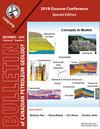The type section of the Canol Formation (Devonian black shale) at Powell Creek: Critical assessment and correlation in the northern Cordillera, NWT, Canada
Q3 Earth and Planetary Sciences
引用次数: 2
Abstract
The Canol Formation is only 24.5 m thick at its historic type section at Powell Creek, northern Mackenzie Mountains, whereas in the off-bank sections of the Mackenzie Plain subsurface, where it is considered a high-quality shale hydrocarbon prospect, it thickens to 60–120 m. This paper reviews available lithological and conodont biostratigraphic information from the type section, discusses choices of contacts and subdivisions, and explores the limits of regional correlation using gamma spectrometry proxies. We position the base of the Canol Formation at the top of the lower resistant unit of the “allochthonous limestone beds”, the thick off-reef debris package present in this outcrop but absent in other well-known Canol sections. The base of the formation can be of a latest Givetian age as suggested by the norrisi zone conodont fauna from the “allochthonous limestone”. The top of the Canol Formation is placed at the base of a distinct, 2.1 m thick horizon with concretionary carbonate beds within the thick shale transition between the Canol and the Imperial formations. Limestone nodules from this horizon produced a conodont fauna that can occur in the jamieae to Upper rhenana zones (Frasnian zones 11–12) thereby suggesting a middle to earliest Late Frasnian age for the Canol top. The cross-section tying several outcrop and well sections across the regional facies zonation reveals that the Dodo Canyon Member, a unit erected in thick off-bank Canol sections, is traceable at Powell Creek. In this correlation, the Vermillion Creek Member, which is the lower portion of the Canol Formation in thick off-bank sections, finds its counterpart in the allochthonous limestone beds sensu MacKenzie (1970). This cross-section is the first correlation of the Canol stratotype at member level available in published sources. Thinness of the Canol Formation at Powell Creek, as well as its location in the carbonate bank toe-of-slope setting, are factors impairing its reference value and calling for more representative sections to act as reference sections and constitute a composite-stratotype for the Canol Formation.Powell Creek地区Canol组(泥盆系黑色页岩)类型剖面:加拿大北部Cordillera地区关键评价与对比
在麦肯齐山脉北部Powell Creek的Canol组历史剖面上,Canol组厚度仅为24.5 m,而在麦肯齐平原的浅海剖面上,Canol组被认为具有高质量的页岩油气远景,厚度可达60-120 m。本文综述了现有的岩性和牙形石生物地层资料,讨论了接触点和细分的选择,并探讨了利用伽马能谱替代方法进行区域对比的局限性。我们将Canol组的底部定位在“异域灰岩层”的较低抵抗单元的顶部,这是该露头中存在的厚的礁外碎屑包,但在其他知名的Canol剖面中却没有。从“异域石灰岩”中的norrisi带牙形石动物群可以看出,该地层的底部可能是最晚的吉夫纪时代。Canol组的顶部位于一个独特的2.1米厚的地层底部,在Canol组和Imperial组之间的厚页岩过渡层中有固结碳酸盐层。来自这一层位的石灰岩结核形成了牙形石动物群,这些牙形石动物群可能出现在jamieae至上雷纳纳带(Frasnian带11-12),从而表明Canol顶部的中期至最早的晚Frasnian时代。将几个露头和井剖面图结合在一起的剖面显示,在Powell Creek可以找到Dodo峡谷段,这是一个建立在厚的离岸Canol剖面上的单元。在这种对比中,Vermillion Creek段是Canol组较低的部分,位于较厚的离岸段,在sensu MacKenzie(1970)的异域石灰岩层中发现了对应的部分。这是在已发表的资料中首次在成员水平上对Canol层型进行对比。Powell Creek Canol组的厚度,以及其位于碳酸盐滩坡脚的位置,都是影响其参考价值的因素,需要更多有代表性的剖面作为参考剖面,并构成Canol组的复合层型。
本文章由计算机程序翻译,如有差异,请以英文原文为准。
求助全文
约1分钟内获得全文
求助全文
来源期刊

Bullentin of Canadian Petroleum Geology
Earth and Planetary Sciences-Geochemistry and Petrology
CiteScore
2.50
自引率
0.00%
发文量
0
期刊介绍:
The Bulletin of Canadian Petroleum Geology is a peer-reviewed scientific journal published four times a year. Founded in 1953, the BCPG aims to be the journal of record for papers dealing with all aspects of petroleum geology, broadly conceived, with a particularly (though not exclusively) Canadian focus. International submissions are encouraged, especially where a connection can be made to Canadian examples.
 求助内容:
求助内容: 应助结果提醒方式:
应助结果提醒方式:


